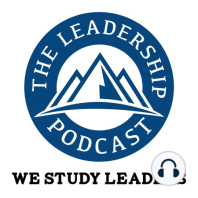42 min listen
TLP328: The Magic Happens Between Busy
ratings:
Length:
44 minutes
Released:
Oct 12, 2022
Format:
Podcast episode
Description
Whitney Johnson is the Co-Founder and CEO of Disruption Advisors, a talent development company. Whitney is a globally-recognized thought leader. author, keynote speaker, executive coach, consultant, and a popular LinkedIn Learning instructor. In this conversation, Whitney discusses how musicality has lessons for the business world, and the wide applications of the S-Curve. https://bit.ly/TLP-328 Key Takeaways [2:35] At her daughter’s prompting during the pandemic, Whitney and her family started watching Korean dramas. The family became obsessed with them. Whitney now studies Korean for two minutes a day on Duolingo. Whitney describes the characteristics of Korean dramas. [5:22] Whitney majored in music, studying classical piano and jazz. Because of her musical background, when she structures a keynote, a book, or a podcast, she looks for musicality and a musical structure to it. Musical structure and musicality inform the work she does. Also, as an experienced accompanist, she knows how to be second, allowing her to be a good interviewer, and as a coach, to listen well. [7:04] Brett Mitchell, the former conductor of the Colorado Symphony, said that music is what happens between the notes. Whitney discusses pauses relating to leadership and cites Clayton Christiansen, saying that partway through his career, Clayton Christiansen started a practice of praying before teaching a class. Once he started that practice, he started to have a significant impact on his students. [8:42] Whitney suggests that before you speak, have a meeting, or a coaching session, you pause and think about the person you’re about to speak to, and how to convey to the person that they matter to you, that is an element of leadership. [10:33] Wayne Muller, author of Sabbath, pointed out the pauses in Martin Luther King’s exclamation, “Free at last! Free at last! Thank God Almighty, we are free at last!” [11:41] Gino Wickman, in The EOS Life, recommends entrepreneurs take sabbaticals. One of Jim’s clients just took a sabbatical and reported that stepping back and taking a break allowed them to reflect and then grow. [12:20] Whitney has a LinkedIn Learning class, Grow Yourself, Grow Your Leaders, and a book, Smart Growth. Whitney’s view is that we are wired to grow. Virtuous growth is growing in such a way that everyone around you grows as well. She believes that human growth is unbounded. [13:23] Sociologist Everett Rogers applied the S-Curve to the study of how quickly innovation is adopted. Working with Clayton Christiansen, Whitney realized she could apply the S-Curve to individual change and growth. Growth comes in three stages: slow (launch), fast (sweet spot), and slow (master place). Every time you start a new role or a new job, you go through the curve. This is covered in Smart Growth. [14:45] Whitney’s LinkedIn course focuses on how to create the conditions where people around you can grow, with the resources they need, and how they can feel connected to what they’re doing and the people they’re working with. Whitney also talks about building resilience and nurturing people. If you can do all those things, you’re creating conditions wherein the people around you can grow. [16:59] Whitney makes the underlying assumption that if you will grow yourself then, by the contagion effect, the people around you will grow. Then, by default, your business will grow. [17:49] You can manage your organization as a portfolio of curves. The people at the curve’s launch point will need the most support. They will also have a fresh perspective, opening the door to innovation. You want about 20% of the people in your organization to be new, 60% to be in the sweet spot, and 20% in master, ready for a new challenge. This is a good distribution for innovation. [20:10] De-prioritize the things you do really well that somebody else could do. Whitney gives an example from a client. If you stop doing the things you should delegate to others, you will have time to do the thin
Released:
Oct 12, 2022
Format:
Podcast episode
Titles in the series (100)
TLP010: Leadership and Followership at all Levels: The benefits of an organization that embraces risk-taking by The Leadership Podcast
